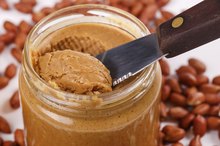What does fact checked mean?
At Healthfully, we strive to deliver objective content that is accurate and up-to-date. Our team periodically reviews articles in order to ensure content quality. The sources cited below consist of evidence from peer-reviewed journals, prominent medical organizations, academic associations, and government data.
The information contained on this site is for informational purposes only, and should not be used as a substitute for the advice of a professional health care provider. Please check with the appropriate physician regarding health questions and concerns. Although we strive to deliver accurate and up-to-date information, no guarantee to that effect is made.
The Best Diets for Inactive Lifestyles
Whether you live an inactive lifestyle due to a disability or you simply do not exercise as much as you should, a healthy diet can help you maintain a healthy body weight and help reduce the risk of developing any obesity-related diseases, such as heart disease or type 2 diabetes. People who live sedentary lifestyles require fewer calories than more active people, so a low-calorie approach to dieting is the best way to go in this case.
DASH Diet
The key to maintaining a healthy body weight when you live a sedentary lifestyle is to minimize the number of calories you consume, and that’s one of the key aspects of the DASH Diet 2. The Dietary Approaches to Stop Hypertension, or DASH, plan was first created to help lower the blood pressure of people with hypertension, but it has been found to be an effective weight loss tool as well 2. According to DashDiet.org, it’s not uncommon for people to experience 10 to 35 lbs. of weight loss within the first few months of starting this diet plan 2. That’s important for people with inactive lifestyles because they are able to lose weight based on diet alone.
The DASH Diet is a safe diet plan endorsed by several credible health organizations, including the U.S. Department of Agriculture and the American Heart Association 2. The DASH plan focuses on low-calorie meals filled with vitamins and nutrients 2. It also limits the amount of salt, sweets and unhealthy fats consumed.
- The key to maintaining a healthy body weight when you live a sedentary lifestyle is to minimize the number of calories you consume, and that’s one of the key aspects of the DASH Diet 2.
Vegetarian Diet
Diets for Hardcore Weight Loss
Learn More
Vegetarianism is a healthy way to live as long as it is done correctly. The advantage that vegetarianism provides is that it the meals are typically low in calories when compared to high-fat meat diets, so it’s an ideal choice for inactive lifestyles.
MyPyramid Customized Diet Plan
The USDA put together the MyPyramid Diet Plan in an effort to help people learn about healthy eating habits 2. People can visit MyPyramid.gov and get a free personalized diet plan based on their age, body type, gender and daily physical activity level. For people with inactive lifestyles, MyPyramid will recommend a low-calorie meal plan that will help them maintain a healthy bodyweight.
The food groups recommended by MyPyramid are based on the USDA’s comprehensive report on nutrition called the Dietary Guidelines for Americans updated every five years. This includes foods like whole grains, fruits, veggies, low-fat dairy and lean meats or protein sources.
- The USDA put together the MyPyramid Diet Plan in an effort to help people learn about healthy eating habits 2.
- For people with inactive lifestyles, MyPyramid will recommend a low-calorie meal plan that will help them maintain a healthy bodyweight.
Related Articles
References
- Mayo Clinic: Vegetarian Diet – How to get the Best Nutrition
- DASH Diet: The DASH Diet Eating Plan
- DASH Eating Plan. National Heart, Lung, and Blood Institute. US Department of Health and Human Services.
- DASH diet: healthy eating to lower your blood pressure. Mayo Clinic. 2019.
- Anand SS, Hawkes C, De souza RJ, et al. Food Consumption and its Impact on Cardiovascular Disease: Importance of Solutions Focused on the Globalized Food System: A Report From the Workshop Convened by the World Heart Federation. J Am Coll Cardiol. 2015;66(14):1590-1614. doi:10.1016/j.jacc.2015.07.050
- Diet Review: DASH. The Nutrition Source. Harvard T.H. Chan School of Public Health.
- Haddad EH, Faed P. Vegetarianism and Veganism in Reference Module in Biomedical Sciences. Elsevier. 2014. doi:10.1016/B978-0-12-801238-3.00241-5
- High blood pressure and diet. US National Library of Medicine. 2019.
- Dietary Guidelines for Americans 2015-2020 (Eighth Edition). U.S. Department of Health and Human Services and U.S. Department of Agriculture. 2015.
- Appendix 7. Nutritional goals for age-sex groups based on dietary reference intakes and Dietary Guidelines recommendations in Dietary Guidelines for Americans 2015-2020 (Eighth Edition). U.S. Department of Health and Human Services and U.S. Department of Agriculture. 2015.
- DASH Diet. Cleveland Clinic. 2016.
- Bolhuis DP, Costanzo A, Newman LP, Keast RS. Salt Promotes Passive Overconsumption of Dietary Fat in Humans. J Nutr. 2016;146(4):838-45. doi:10.3945/jn.115.226365
- Chiu S, Bergeron N, Williams PT, Bray GA, Sutherland B, Krauss RM. Comparison of the DASH (Dietary Approaches to Stop Hypertension) diet and a higher-fat DASH diet on blood pressure and lipids and lipoproteins: a randomized controlled trial. Am J Clin Nutr. 2016;103(2):341-7. doi:10.3945/ajcn.115.123281
- Get a complete & convenient weight-loss solution. Jenny Craig.
- Muñoz obino KF, Aguiar pereira C, Caron-lienert RS. Coaching and barriers to weight loss: an integrative review. Diabetes Metab Syndr Obes. 2017;10:1-11. doi:10.2147/DMSO.S113874
- Find an expert. Academy of Nutrition and Dietetics.
- In brief: your guide to lowering your blood pressure with DASH. National Institutes of Health. National Heart, Lung, and Blood Institute. 2015.
- Tyson CC, Nwankwo C, Lin PH, Svetkey LP. The Dietary Approaches to Stop Hypertension (DASH) eating pattern in special populations. Curr Hypertens Rep. 2012;14(5):388-96. doi:10.1007%2Fs11906-012-0296-1
- The DASH Eating Plan. National Institutes of Health. National Heart, Lung, and Blood Institute.
- Appel, L. J., Moore, T. J., Obarzanek, E., Vollmer, W. M., Svetkey, L. P., Sacks, F. M., … Harsha, D. W. (1997). A Clinical Trial of the Effects of Dietary Patterns on Blood Pressure. New England Journal of Medicine, 336(16), 1117–1124. doi:10.1056/nejm199704173361601
- Campbell, A. P. (2017). DASH Eating Plan: An Eating Pattern for Diabetes Management. Diabetes Spectrum, 30(2), 76–81. doi:10.2337/ds16-0084
- Kwan, M. W.-M., Wong, M. C.-S., Wang, H. H.-X., Liu, K. Q.-L., Lee, C. L.-S., Yan, B. P.-Y., … Griffiths, S. M. (2013). Compliance with the Dietary Approaches to Stop Hypertension (DASH) Diet: A Systematic Review. PLoS ONE, 8(10), e78412. doi:10.1371/journal.pone.0078412
- Rai Sharan K, Fung Teresa T, Lu Na, Keller Sarah F, Curhan Gary C, Choi Hyon K et al. The Dietary Approaches to Stop Hypertension (DASH) diet, Western diet, and risk of gout in men: prospective cohort study BMJ 2017; 357 :j1794 DOI: 10.1136/bmj.j1794
- Sally Chiu, Nathalie Bergeron, Paul T Williams, George A Bray, Barbara Sutherland, Ronald M Krauss, Comparison of the DASH (Dietary Approaches to Stop Hypertension) diet and a higher-fat DASH diet on blood pressure and lipids and lipoproteins: a randomized controlled tria The American Journal of Clinical Nutrition, Volume 103, Issue 2, February 2016 DOI: 10.3945/ajcn.115.123281
- Schwingshackl, L., Chaimani, A., Schwedhelm, C., Toledo, E., Pünsch, M., Hoffmann, G., & Boeing, H. (2018). Comparative effects of different dietary approaches on blood pressure in hypertensive and pre-hypertensive patients: A systematic review and network meta-analysis. Critical Reviews in Food Science and Nutrition, 1–14. doi:10.1080/10408398.2018.146396
- Siervo, M., Lara, J., Chowdhury, S., Ashor, A., Oggioni, C., & Mathers, J. C. (2014). Effects of the Dietary Approach to Stop Hypertension (DASH) diet on cardiovascular risk factors: a systematic review and meta-analysis. British Journal of Nutrition, 113(1), 1–15. doi:10.1017/s0007114514003341
- Tyson, C. C., Nwankwo, C., Lin, P. H., & Svetkey, L. P. (2012). The Dietary Approaches to Stop Hypertension (DASH) eating pattern in special populations. Current hypertension reports, 14(5), 388–396. doi:10.1007/s11906-012-0296-1
Writer Bio
Joseph Eitel has written for a variety of respected online publications since 2006 including the Developer Shed Network and Huddle.net. He has dedicated his life to researching and writing about diet, nutrition and exercise. Eitel's health blog, PromoteHealth.info, has become an authority in the healthy-living niche. He graduated with honors from Kellogg Community College in 2010 with an Associate of Applied Science.








